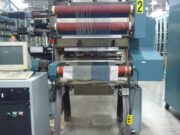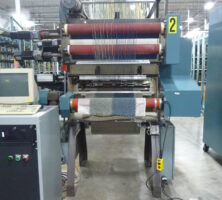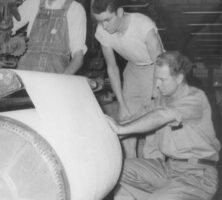“Like a story-book romance reads the history of the colorful tufted textile industry.” So the Tufted Textile Manufacturers Association boasted in its 1950 directory. “No other industry,” according to the trade association, “can boast so phenomenal a growth all within the lifetime of its founder,” Whitfield County native Catherine Evans Whitener. Whitener had revived the handcraft of tufting in the 1890s. The craft spread like wildfire, and by the 1920s thousands of men and women in north Georgia, the Carolinas, and Tennessee had created a thriving cottage industry in the production of tufted bedspreads. In the 1930s mechanics adapted surplus industrial-grade Singer sewing machines from the New York garment trades for use in the burgeoning industry. The new tufting machines speeded the industry’s conversion from home manufacture to factories and encouraged it to move toward mass production.
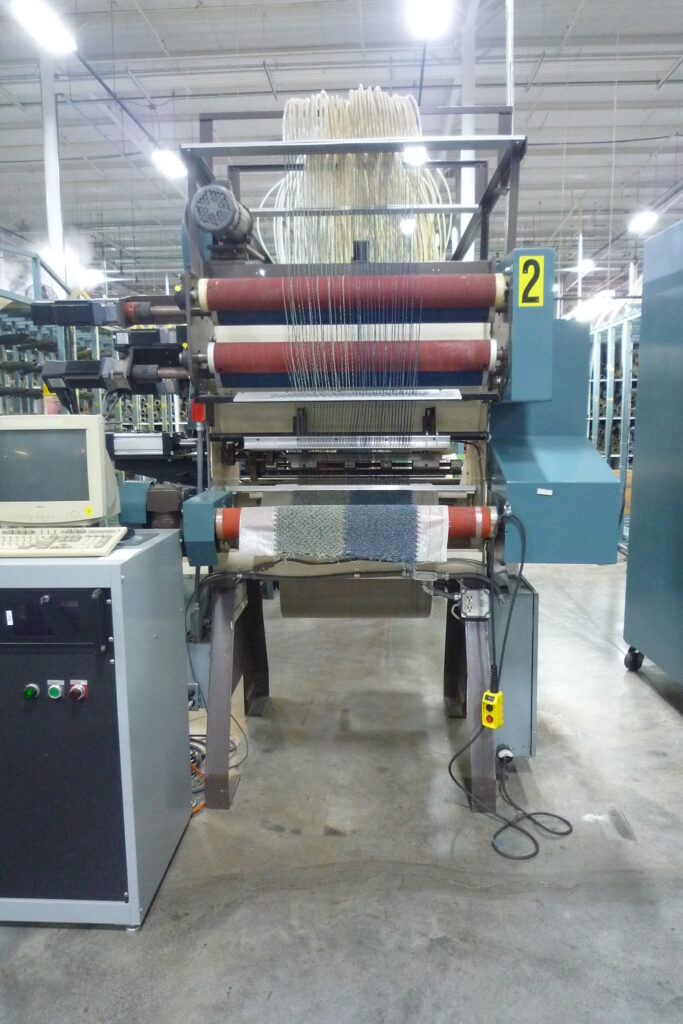
Photograph by Charles & Hudson
Dalton, Georgia, became the center of production for this new industry, as the growing number of manufacturers encouraged the development of specialized machine shops. Dalton also benefited from a textile heritage that included cotton mills and thread and hosiery mills. The new tufting industry drew on the existing base of textile capital, materials like yarn and cotton sheeting, and technical and managerial expertise. In the 1930s and 1940s companies that had concentrated on manufacturing bedspreads introduced new products, including tufted robes, toilet seat and tank covers, and most important, small throw rugs (generally called scatter rugs in the trade). By the late 1940s this array of tufted-textile consumer goods produced annual sales of more than $50 million, with the bulk of the sales going to retailers and distributors outside Georgia (indeed, outside the South).
New Technology
Yet tufted textiles had only just begun to grow by 1950. The bedspread boom had sparked the creation of a regional machine-building industry. Firms like Cobble Brothers in Chattanooga, Tennessee, and Cabin Crafts in Dalton experimented with larger and larger tufting machines. The effort to produce a tufting machine wide enough to mass-produce bedspreads combined with the growing popularity of scatter rugs to inspire the most ambitious, and successful, innovation of the Dalton industrial complex: a carpet tufting machine. Dalton manufacturers and machine makers quickly adapted the wide tufting machines for the production of room-sized rugs and wall-to-wall carpeting. Up to 1950, the production of carpets and larger rugs had been concentrated in the Northeast. A handful of large firms like Connecticut’s Bigelow-Sanford and New York’s Mohawk Carpet Mills dominated a relatively low-volume industry that produced high-priced goods. Northern mills used traditional woven technology (power looms) and a relatively expensive natural fiber, wool.
Around 1950 old spread-making firms like Cabin Crafts and brand new maverick companies like E. T. Barwick Mills (based in Chamblee with mills in Dalton and Lafayette) began using tufting machines to cover the entire surface of a room-sized piece of backing material with raised tufts of yarn. Working primarily with cotton, the new manufacturers could produce carpets that resembled woven goods. The new tufting process was much more efficient. A tufted cotton carpet sold for about half the cost of a similar woven wool product. Cotton carpets were of poorer quality, however, and woven manufacturers derided the new products as glorified bedspreads. Du Pont helped the new industry solve this problem by introducing bulked continuous filament (BCF) nylon in 1957. Georgia tufting companies had already begun catching up with woven manufacturers even as they worked with inferior materials. Du Pont’s nylon fibers proved comparable to wool in performance but remained inexpensive. The marriage of the new production technology with synthetic fibers like BCF nylon created an economic boom in northwest Georgia.
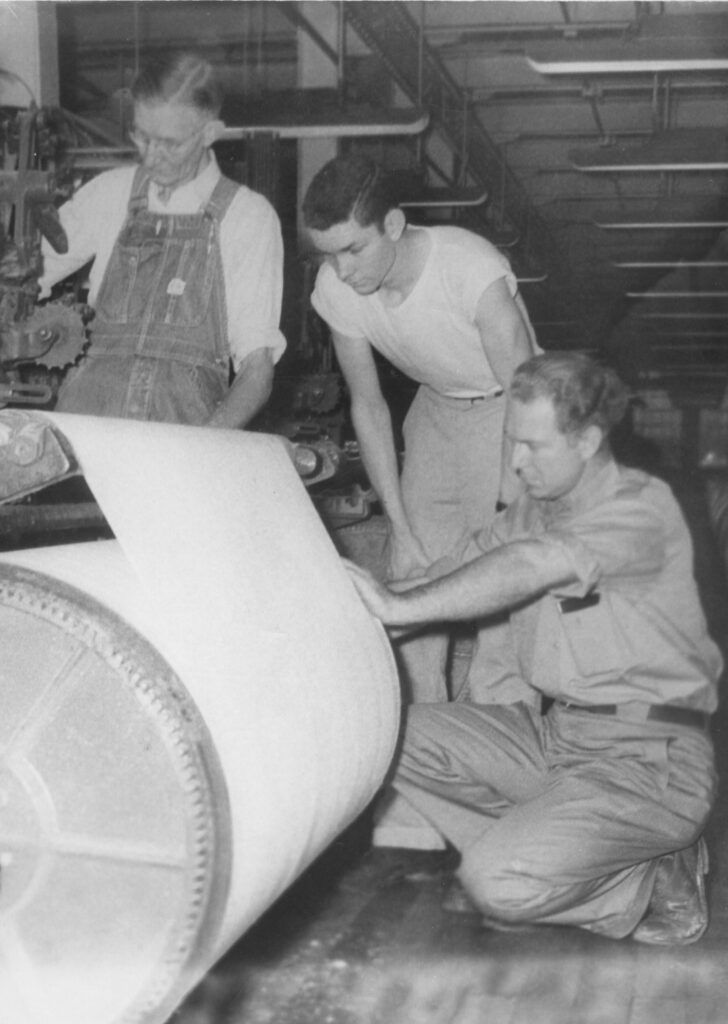
Courtesy of Thomaston-Upson Archives
The Gold Coast: Growth in the 1960s
Tufting and nylon opened up vast new markets for carpet. The old woven manufacturers had long complained about the slow growth of their industry; per capita carpet consumption in 1950 was about the same as it had been two decades earlier. Dalton’s tufting mills changed the equation dramatically. The new technology meshed perfectly with the economic boom of the post–World War II (1941-45) years, and middle-class consumers freely substituted tufted products for woven.
Carpet consumption followed the price trend. As tufted goods brought down prices, consumers covered more and more floor space with carpets. The average mill value of a square yard of carpet in 1950 (when all carpets were woven wool) stood at $6.24. By 1970 the average price had dropped to $3.56, with tufted carpets representing 90 percent of total industry volume. Per capita consumption skyrocketed from two square yards per household in 1950 to nearly eight and a half square yards in 1970. Carpet industry sales topped $1 billion annually in the early 1960s and surpassed $2 billion in the early 1970s. The carpet industry became the fourth-fastest-growing industry in the United States during the 1960s, surpassed only by television picture tubes, aircraft, and computers.
Through all this growth, the industry became more and more concentrated in the Dalton area. Tufting machinery was cheap, and specialized dyeing and finishing companies (many of which had emerged to serve the old bedspread industry) offered contract services to manufacturers, minimizing the capital investment necessary to enter carpet production. Tufting machines were relatively inexpensive, machine makers like Cobble offered in-house financing, and by the mid-1960s secondhand machines were increasingly available. With low barriers to entry and a booming market, new firms proliferated. Industry leader Robert Shaw characterized Dalton in the 1960s as “the gold coast,” and miners abounded.
The number of competitors in the carpet industry grew from 88 in 1958 to more than 400 by the late 1970s, with a majority of those firms located in Georgia. This rapid multiplication of new firms clearly required financing, always difficult in the capital-poor South. Entrepreneurs in Georgia’s carpet district entered into factoring relationships with regional banks and northern companies. C&S Bank and the Trust Company Bank, predecessor to SunTrust Banks (now Truist), played leading roles among Georgia financial institutions in offering this type of credit. The Walter E. Heller Company, based in Chicago, Illinois, was the most important national firm in the growth of factoring. Financial institutions advanced credit against a carpet maker’s accounts receivable. Factors often provided credit-checking and collection services to their clients. The cost of such credit, however, generally was high. New firms entering a business that many observers thought to be a flash in the pan had difficulty obtaining any other kind of credit in the early years. By the late 1970s such leading firms as Shaw Industries had begun to move away from this high-cost credit.
Turning Point: The 1980s
The recession of 1981-82 proved a turning point for Georgia’s carpet industry. Most observers agreed that the industry would probably never return to its double-digit annual growth rates of the 1950s and 1960s. Many smaller firms, and some larger ones, struggled and failed in the new slow-growth environment. A new industry leader emerged in the 1980s—Shaw Industries. Shaw pursued vertical integration, reaching forward directly to retailers and backward to yarn spinning, and finally to processing nylon chips. Shaw already incorporated dyeing and finishing, having started as a commission-finishing firm in the 1960s. Shaw’s cost reduction and efficiency measures proved very successful. Shaw became the largest manufacturer in the industry by 1986, then began acquiring struggling rivals (including Cabin Crafts, by then a subsidiary of textile giant West Point). Shaw thus initiated the consolidation of this overcrowded industry.
By the turn of the twenty-first century, four companies controlled more than 80 percent of the market for carpet in the United States. All four were based in Georgia. Three—Shaw, Mohawk (which moved its corporate headquarters to Georgia in the 1980s and acquired a number of Dalton-area tufted carpet manufacturers), and newcomer Beaulieu (owned by Belgian interests)—were located in the Dalton area; the fourth, Interface,was based in LaGrange. Interface differed significantly from the other giants. Shaw, Mohawk, and Beaulieu all generated the bulk of their revenues from sales of residential carpeting, the largest single carpet market segment. Interface’s success was due to its overwhelming dominance in a particular market niche—modular carpet tiles, particularly useful in office and institutional settings. Interface’s founder, Ray Anderson, became something of a celebrity with a well-publicized conversion to “sustainable development” in the mid-1990s.
The leading carpet maker, Shaw Industries, became part of Warren Buffett’s Berkshire-Hathaway holding company in 2001. Buffett, perhaps the most famous investor in the nation at the time, had built his Berkshire-Hathaway firm into a Wall Street giant by buying undervalued stocks and well-managed, profitable companies—mostly in “old economy” arenas such as manufacturing and insurance—and holding them. Buffett also had a tradition of keeping the existing corporate management in place and allowing them to continue running their companies with little interference. Thus Shaw Industries’ founder, Robert E. Shaw, remained as chairman and chief executive officer after the acquisition. Shaw even retained its own independent company identity, corporate logo, etc.
The Labor Question
The concentration of manufacturing activity in northwest Georgia exacerbated a South-wide textile trend in the post–World War II years—labor shortages. Since the 1950s Dalton mill owners have regularly complained of a shortage of workers. The Textile Workers Union of America tried twice to organize the Dalton area’s tufted textile workers. The union’s efforts failed in the McCarthy era of the mid-1950s, primarily because the trade association was able to associate union advocates with radicalism and communism.
In the early 1960s the union renewed its efforts and took great care to distance itself from radical elements. Manufacturers responded to this drive with a vigorous campaign coordinated by the trade association. Mill owners promised to maintain the recent trend toward growth and prosperity in the region but cautioned that all the progress of the past decades could be squandered if workers joined the union.
The tactic worked, and the union campaign experienced only limited success. The vast majority of the region’s workers remained unorganized. Mill workers changed jobs frequently, looking for slightly higher wages or more amenable managers. “A world of opportunity” existed “within the tufting empire,” according to one study, and the proliferation of new firms and concentration of carpet manufacturing in northwest Georgia offered real, though limited, advantages. By the 1980s manufacturers believed that the labor shortage threatened the continued existence of the heavy concentration of mills in northwest Georgia.
The Industry Today
The carpet industry remains heavily concentrated in Georgia in the twenty-first century. Of the industry’s $11 billion in wholesale sales in 1997, Georgia establishments accounted for more than $8 billion, and 32,000 of the industry’s 50,000 workers toiled in Georgia mills. Unemployment rates in Whitfield, Murray, Gordon, and Bartow counties (the heart of the carpet district) were consistently among the lowest in the state. During the late 1980s and 1990s manufacturers found a solution to the vexing labor shortage; Hispanic workers, many of them illegal immigrants, began moving to the Dalton area in large numbers. As Georgia’s carpet industry entered the new millennium, a large portion of the mill workforce consisted of Hispanic immigrants (no reliable numbers existed as of early 2000, but estimates ran from one-quarter to one-half). Children of Hispanic descent made up close to half the student population in the Dalton city schools in 1999. The rapid influx of Hispanic labor has caused social tension, but manufacturers lauded the newcomers for their work ethic. According to a Textile World magazine feature, mill owners regarded Hispanic workers as the”saviors” of the industry, allowing the mills to remain in Dalton and keeping labor costs in check.
The easy conclusion might be that Dalton’s mill owners simply imported and exploited cheap immigrant labor, yet the reality was at least a bit more complex. The liberal magazine The Nation, for example, lauded Dalton’s corporate and civic leaders for their efforts to promote a welcoming atmosphere for immigrants within the community. Perhaps the best example of that was the Georgia Project, the brainchild of Erwin Mitchell, a local lawyer. Mitchell, with the help of Robert Shaw and partners at Mexico’s University of Monterrey, established a pioneer program in 1997 to promote bilingual education in Dalton’s public schools. The Georgia Project brought Spanish-speaking teachers to Dalton to assist with the burgeoning Hispanic population in the city’s schools and sent Dalton teachers to Mexico to learn Spanish. With this initiative and others, Dalton sought to smooth the process of globalization for this industry and the community that had spawned it.


